Linear Bearings
Linear bearings, also known as linear-motion bearings, linear slides or linear actuators, are precision-engineered mechanisms that facilitate smooth, controlled movement for a diverse array of machine components. These bearings are specifically designed to enable motion along a straight path, ensuring consistent and reliable performance in applications where precise linear travel is essential.
In most cases, the object mounted on linear bearings requires movement in a single direction, which allows for a straightforward yet highly effective design. These bearings operate with remarkable consistency, delivering repetitive motion with exceptional fluidity, minimizing friction, and enhancing overall system efficiency.
The History of Linear Bearings
- Beginning History of Linear Bearings
- Bearings have existed in various forms since ancient times, possibly predating the invention of the wheel. Early civilizations utilized rolling bearings, with the earliest known examples crafted from wood. The most tangible evidence of early roller bearings comes from the remains of a Roman shipwreck dated to approximately 40 BC. However, additional archaeological findings, including Egyptian hieroglyphs and tomb illustrations, suggest that the concept of linear motion was understood and applied even earlier. These depictions show the use of tree trunks as rolling supports beneath sleds, sledges fitted with liquid-lubricated runners akin to plain bearings, and primitive bearings used in hand drills.
- Around 1500 AD, Leonardo da Vinci included drawings of ball bearings in his conceptual helicopter design, marking the first recorded reference to linear bearings in an aerospace-related application. Later, Italian engineer Agostino Ramelli produced sketches detailing roller and thrust bearings, which were further refined in the 17th century when Galileo proposed enclosing rolling elements within a cage to minimize friction.
- By the mid-18th century, these theoretical advancements began materializing in practical applications. In the 1740s, John Harrison incorporated caged-roller bearings into his H3 marine timekeeper, improving timekeeping precision. The transition to modern linear bearings took a significant leap in 1794 when British inventor Philip Vaughan patented the first ball bearing system, featuring a ball rolling within a grooved axle assembly. This period also coincided with the height of the Industrial Revolution, during which linear bearings played a crucial role in ensuring the efficient operation of wheel and axle systems, improving precision in watchmaking, and enhancing the performance of water mills.
- Later History of Linear Bearings
- The late 19th century ushered in new styles and applications for linear bearings. In 1869, a Parisian bicycle mechanic patented the radial-style ball bearing, marking a significant innovation in bearing design. Henry Timken followed in 1898 with the tapered roller bearing, further expanding the functional capabilities of bearings. Meanwhile, in 1883, Friedrich Fischer introduced a method for milling and grinding bearing balls with consistent size and shape, laying the groundwork for a fully developed bearing manufacturing industry.
- At the dawn of the 20th century, the industry saw further refinement, including the development of the self-aligning linear ball bearing in 1907. Progress continued through the 1930s, particularly with the invention of the wire race bearing in 1934. World War II spurred additional innovation, and from the 1960s through the 1980s, the industry introduced new technologies such as v-groove bearing guide wheels, bi-material plain bearings, and bearings constructed from Teflon-based materials.
- Today, linear bearings serve in cutting-edge applications across numerous industries. They support high-speed operations in dental drills, ensure precision in aerospace applications such as the Mars Rover, and contribute to the accuracy of optical alignment systems through flexure bearings. Their increasing popularity is largely driven by advances in robotic automation, which demand reliable, efficient, and highly durable linear motion solutions.
Advantages of Linear Bearings
Linear bearings provide immense value across a wide range of applications. Their primary advantage lies in their function: they enable smooth, unrestricted movement along a designated path, whether in a straight line or multi-directional configurations. Their ease of installation, cost-effectiveness, and low energy requirements further contribute to their appeal. Additionally, their high level of customization allows engineers to tailor them to specific operational needs, making them indispensable in both traditional and high-tech applications.
Linear Bearings Design
To ensure linear bearings function effectively, manufacturers have several design options for motion mechanisms. These mechanisms generally fall into two categories: rolling and plain, with the majority belonging to the rolling category. Rolling mechanisms include balls, slides, and rails, each offering distinct advantages and requiring different assembly techniques.
- Rolling Elements
- Linear bearings utilizing rolling elements consist of a sleeve-like ring and a systematically arranged row of balls enclosed within precision-engineered cages. These cages, along with the balls, are typically constructed from hardened metal to ensure exceptional durability and strength. Functionally, the cage serves as a rail, while the balls act as rollers. To facilitate smooth, noise-free operation, the surfaces of both the rails and rollers are finely finished, often supplemented with lubricants that minimize friction and enhance movement efficiency.
- One of the most significant advantages of rolling element linear bearings is their superior strength and highly reliable motion. While most of these systems require manual input to initiate movement, modern advancements have introduced computerized, intelligent linear bearings. These advanced models operate through remote controls or control panels, utilizing either electric power or battery-operated systems to enable automated motion.
- Plain Elements
- In addition to rolling element bearings, plain bearings provide an alternative design without the use of balls or rollers. While their applications in industrial settings are more limited, they remain viable for specific use cases where simplicity and minimal maintenance are priorities.
- Linear bearings are commonly manufactured using robust materials such as cast iron, hard-coat aluminum, and stainless steel. However, more flexible materials like bronze, plastic, PTFE, and acetal are also utilized, particularly when specific weight, corrosion resistance, or friction reduction properties are required.
Linear Bearings Images, Diagrams and Visual Concepts
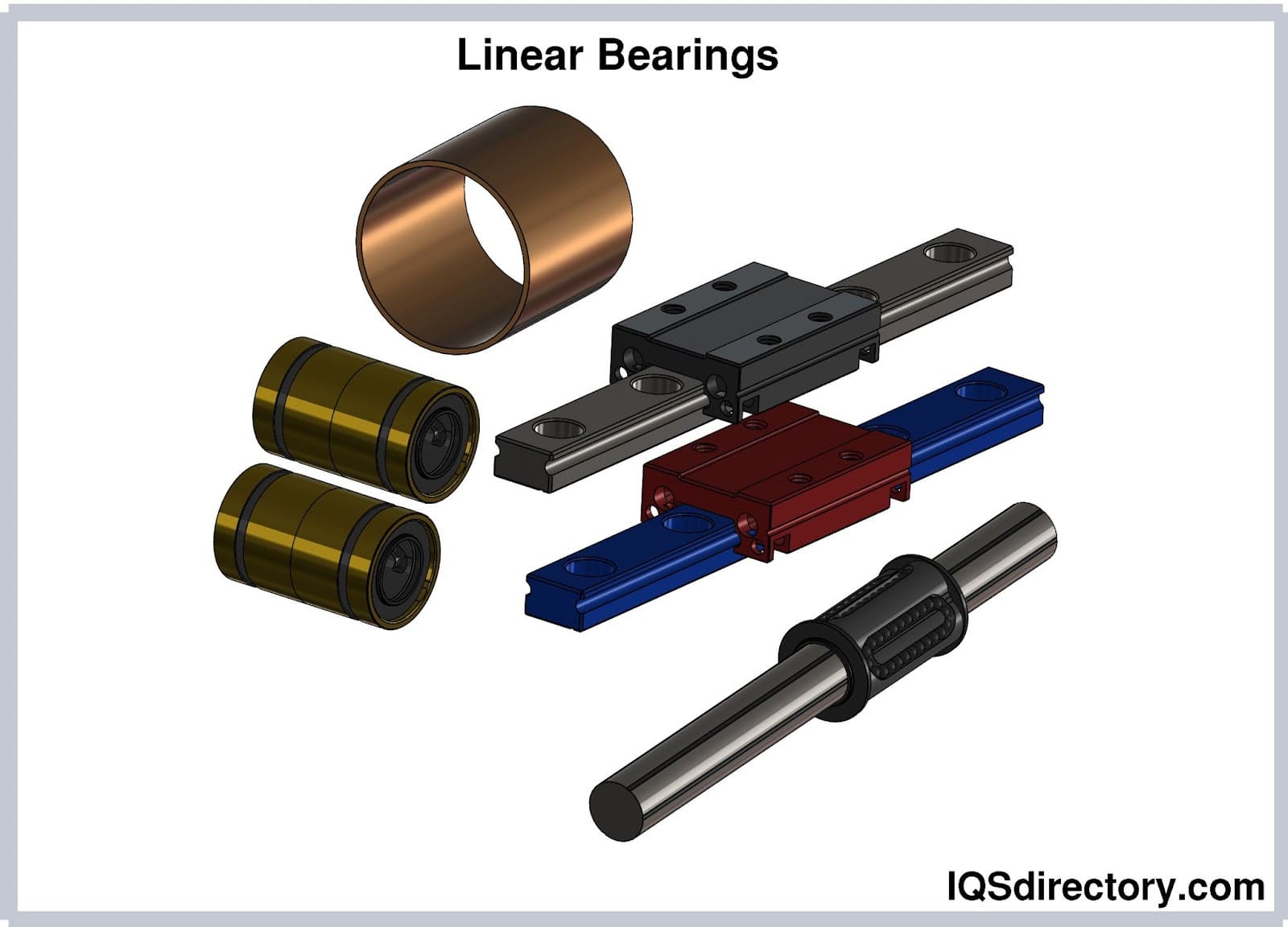 Linear bearings supports the load of the carriage during its single-axis linear movement and provide a low friction sliding surface for the guide rails.
Linear bearings supports the load of the carriage during its single-axis linear movement and provide a low friction sliding surface for the guide rails.
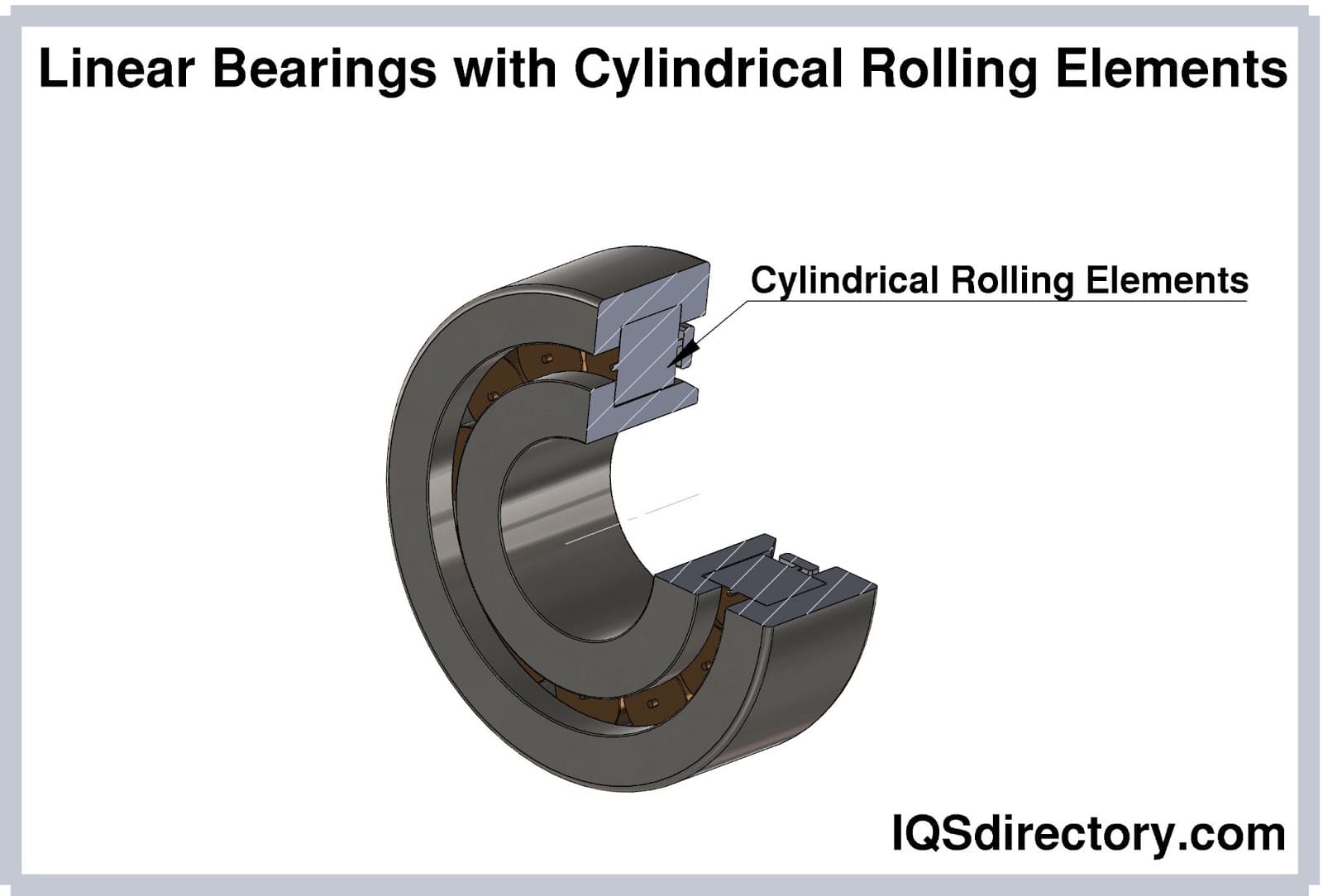 Linear bearings that have cylindrically shaped rolling elements, they have higher load capacity, rigidity, and impact resistance than ball bearings.
Linear bearings that have cylindrically shaped rolling elements, they have higher load capacity, rigidity, and impact resistance than ball bearings.
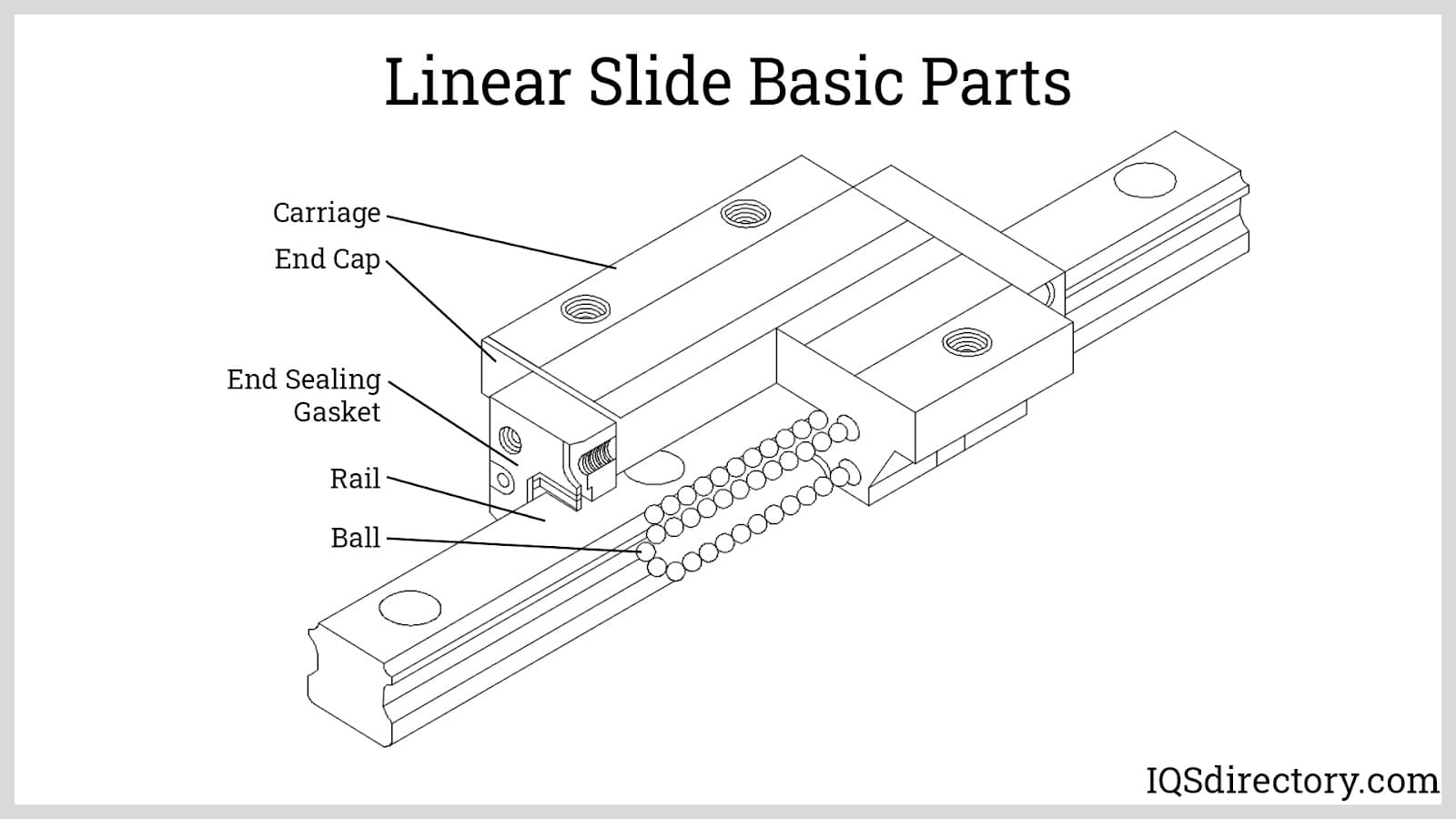 The basic parts for a linear slider.
The basic parts for a linear slider.
 The circular arch creates less friction, while gothic arches have a higher load capacity.
The circular arch creates less friction, while gothic arches have a higher load capacity.
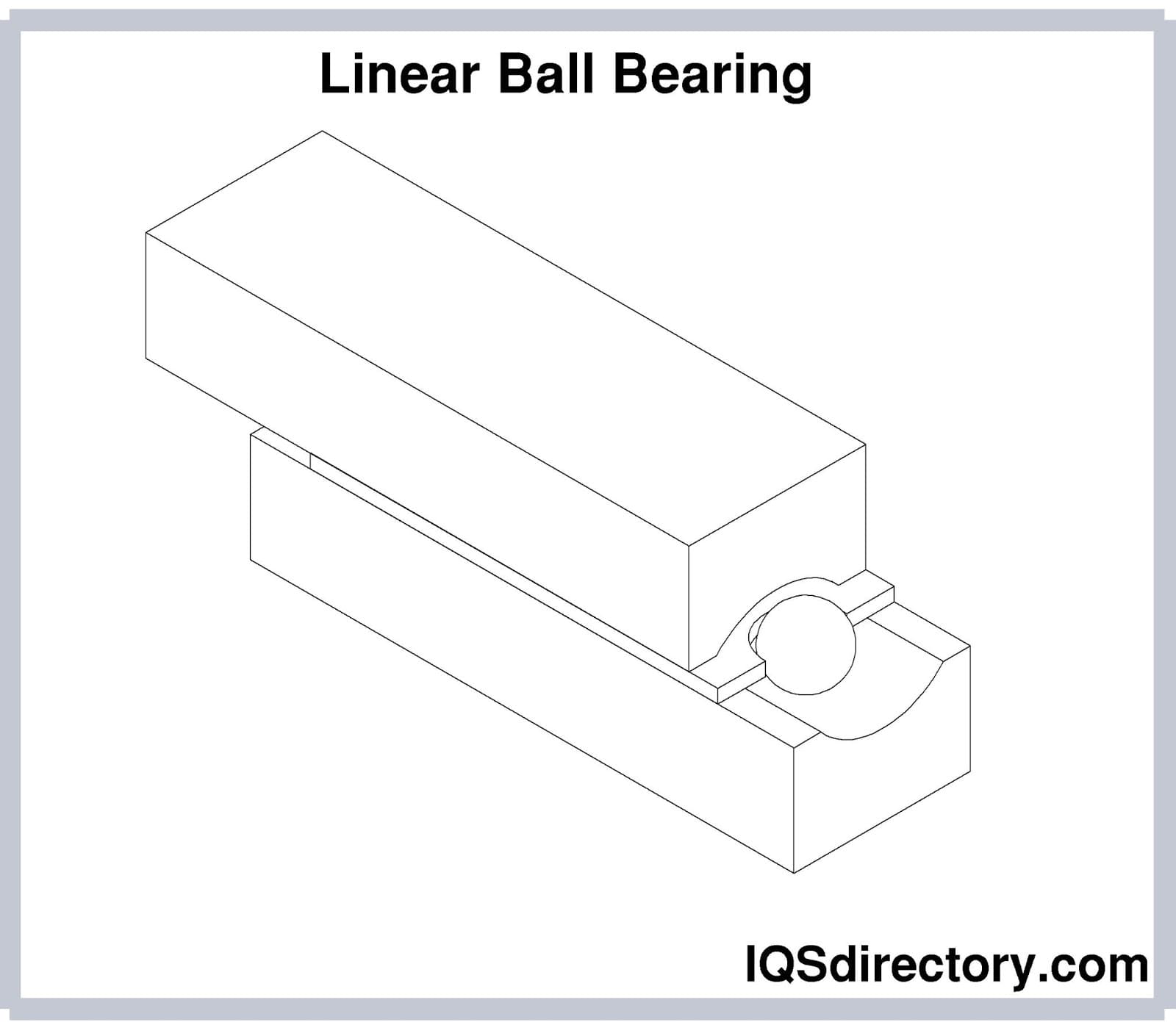 Non-recirculating linear ball bearings have metal balls fixed on the cage, the mating grooves of the bearing and the guide rail.
Non-recirculating linear ball bearings have metal balls fixed on the cage, the mating grooves of the bearing and the guide rail.
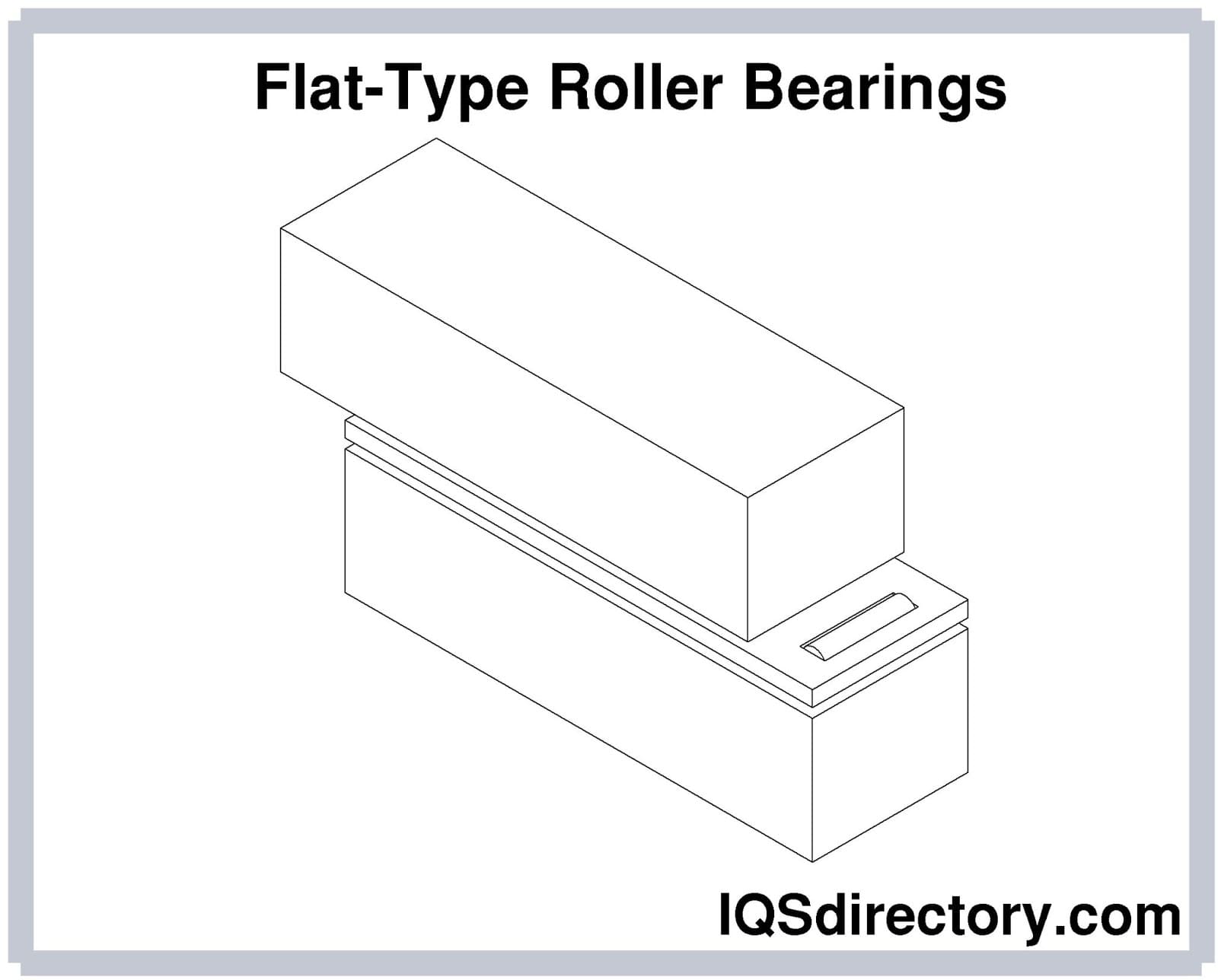 lat-type roller bearings have cylindrical lying on their horizontal axis in the cage.
lat-type roller bearings have cylindrical lying on their horizontal axis in the cage.
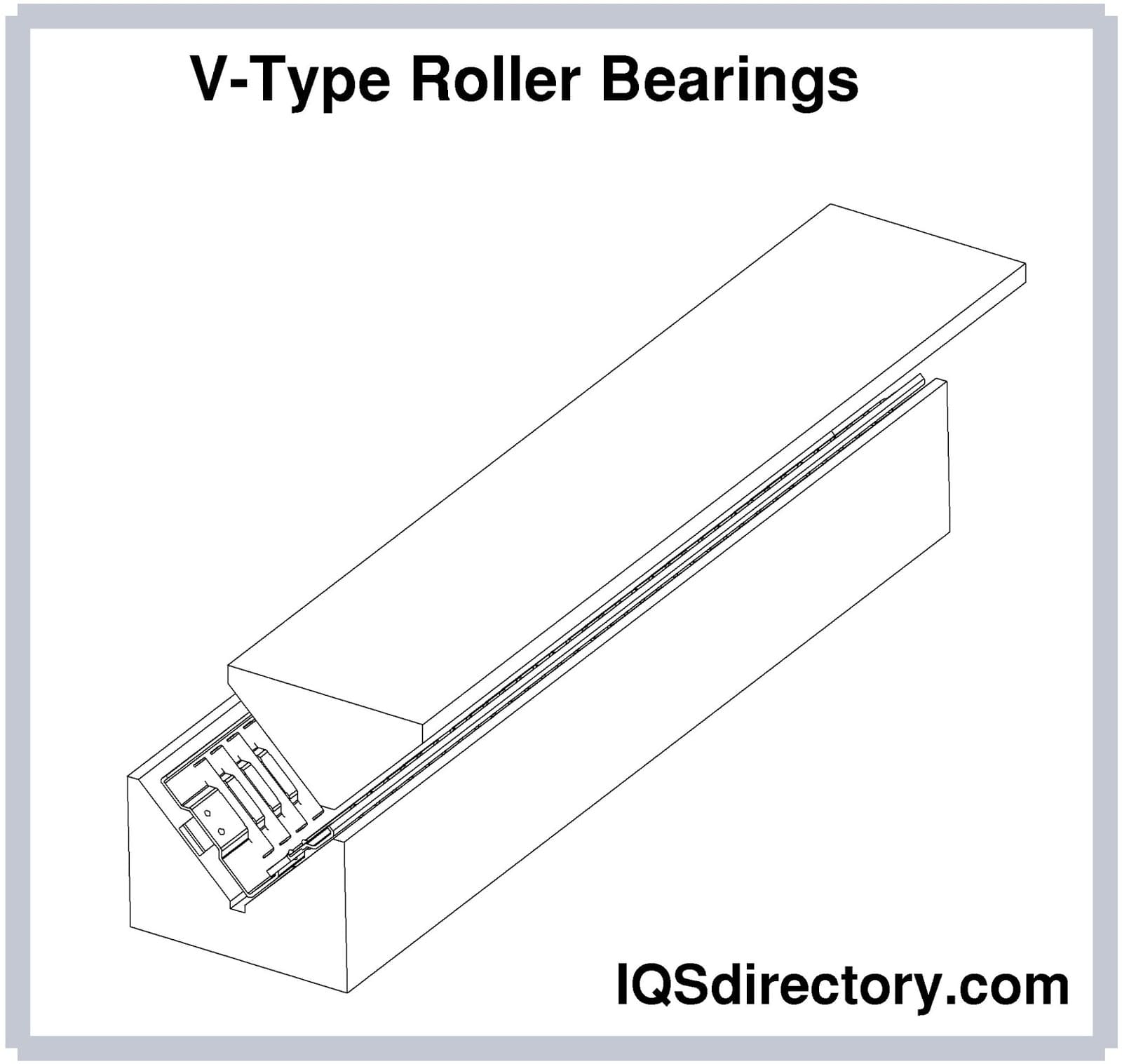 V-type roller bearings have a V-shaped pathway, forming a 90° angle.
V-type roller bearings have a V-shaped pathway, forming a 90° angle.
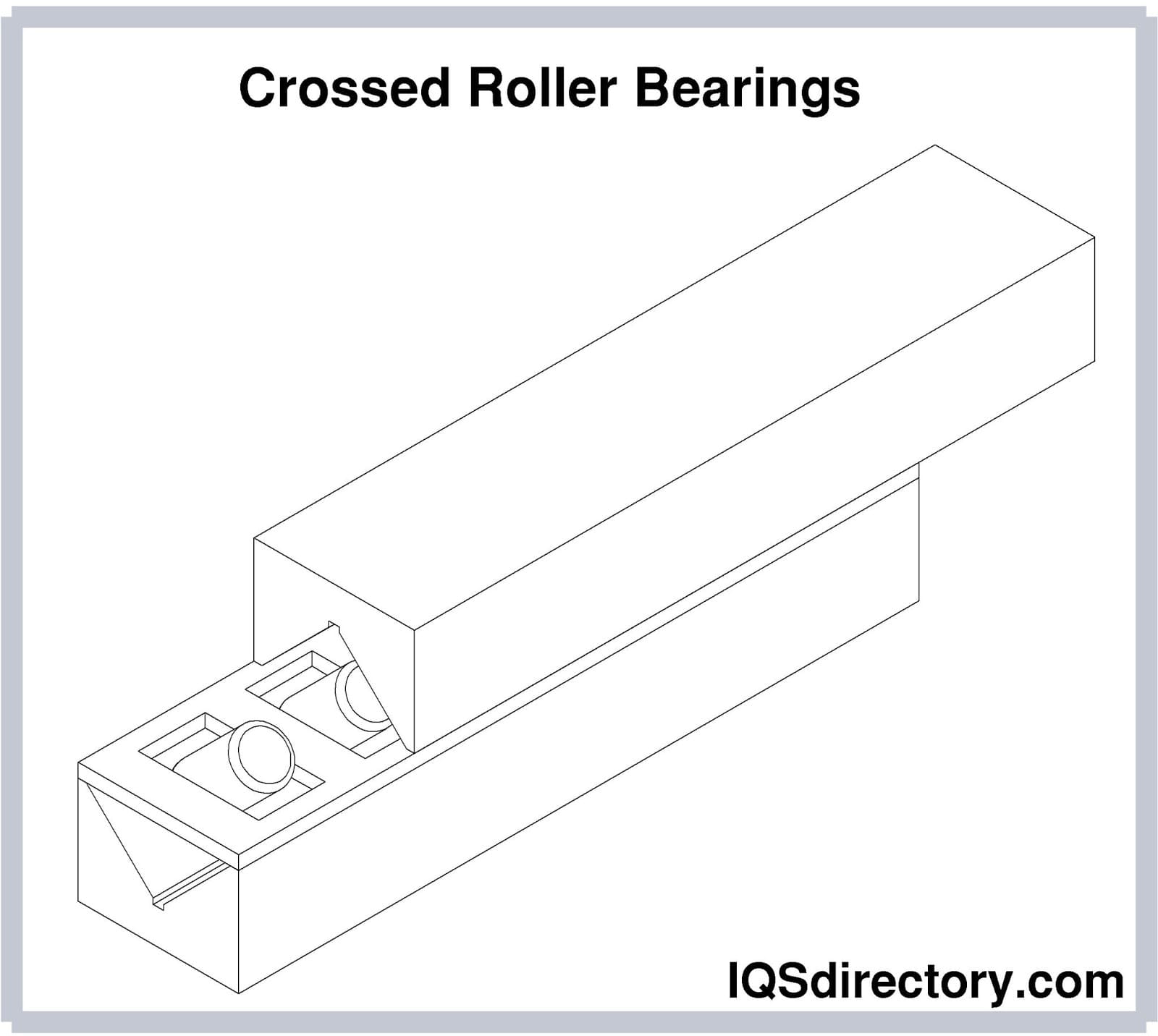 Crossed roller bearings have cylindrical rollers which forms a 90° angle with its cylinders, which forms a crisscross pattern among the rollers.
Crossed roller bearings have cylindrical rollers which forms a 90° angle with its cylinders, which forms a crisscross pattern among the rollers.
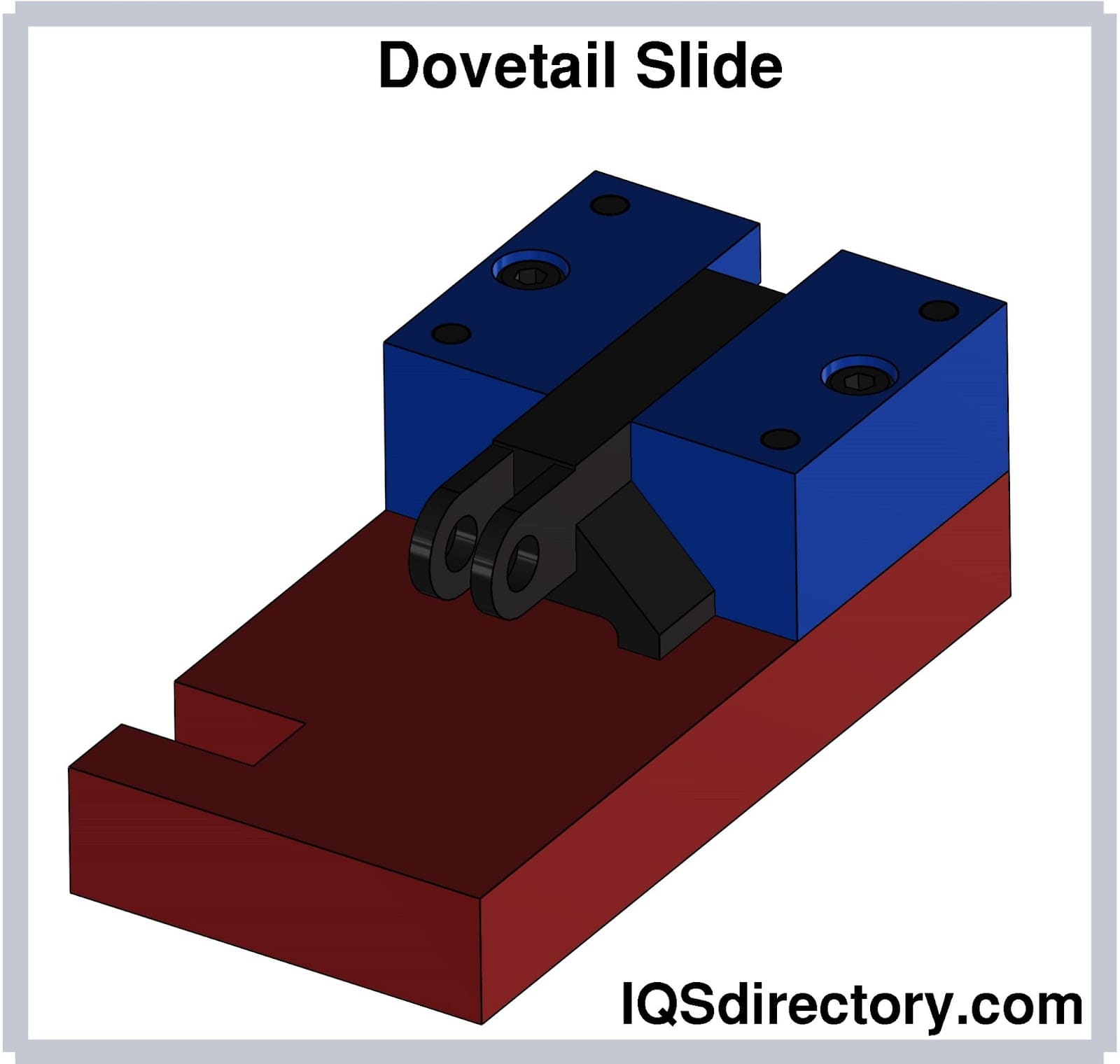 Dovetail slide, a linear bearing with a protruding V-shaped tongue and a mating saddle with a full contact with each other.
Dovetail slide, a linear bearing with a protruding V-shaped tongue and a mating saddle with a full contact with each other.
Types of Linear Bearings
Linear bearings come in various designs, each tailored to meet specific motion and load-bearing requirements. The three primary types include linear ball bearings, linear roller bearings—such as needle bearings—and slide bearings. Beyond these, there are numerous specialized linear bearing types, each engineered for distinct applications, including crossed roller bearings, precision linear bearings, miniature linear bearings, linear rotary bearings, linear air bearings, pillow block linear bearings, dovetail slides, ball screws, rail bushing bearings, and profile rail bearings.
- Linear Ball Bearing
- As a particularly efficient type of rolling element bearing, linear ball bearings employ a hard-rolling ball element to separate two moving parts along a straight path. Designed to provide smooth, low-friction linear motion in rotary applications, they come in two primary variations: radial ball bearings, which support both radial and axial loads, and thrust ball bearings, which handle pure thrust loads. Commonly found in delicate instrumentation, robotic assembly, cleanroom environments, and high-end appliances, these bearings are self-lubricating, requiring no additional lubrication to maintain seamless motion.
- Linear Roller Bearing
- A subcategory of rolling element linear-motion bearings, linear roller bearings differ from motorized systems by being manually operated. They use cylindrical rollers positioned between two objects, distributing the load more evenly across the contact surface. With a high load capacity, these bearings are self-cleaning, cost-effective, and simple to implement, making them a preferred choice for budget-conscious operations or applications requiring controlled, non-electric motion.
- Needle Bearing
- A specialized form of roller bearing, needle bearings feature thin, cylindrical rollers with a smaller diameter. Their compact design allows for efficient load handling in applications requiring precise movement and high rigidity.
- Slide Bearing
- Using low-friction materials such as Teflon or graphite embedded in metal backing plates, slide bearings facilitate linear motion while supporting weight. These are frequently used in high-temperature environments, including heated pipelines on oil production modules, steel fabrication processes, and oil or water transportation systems.
- Crossed Roller Bearing
- Engineered for applications requiring greater load capacity than ball slides, crossed roller bearings feature rollers arranged in an alternating pattern, allowing them to handle high loads with greater stability.
- Precision Linear Bearing
- Designed for machine-tool spindles and other high-precision applications, precision linear bearings offer exceptional accuracy, durability, and tight bearing tolerances, making them ideal for industries requiring exacting motion control.
- Miniature Linear Bearing
- These bearings operate at low torque while delivering high-performance motion, particularly in applications where minimal noise, minimal run-out, and extended operational life are critical.
- Linear Rotary Bearing
- Used in scenarios where precise linear movement of large objects is required, linear rotary bearings feature cylindrical rollers capable of dividing and supporting heavy loads. Their self-lubricating nature makes them ideal for use in car axles, machine shafts, clock components, and grinders.
- Linear Air Bearing
- Utilizing crossed roller slide assemblies controlled by air cylinders, linear air bearings enable frictionless motion by suspending the moving component on a cushion of air. Available in round or rectangular designs with optional vacuum and magnetic preloads, they are frequently employed in aerospace and precision machine tool applications. Made from lightweight materials like aluminum, linear air cylinders are widely used for tensile testing and precision positioning.
- Pillow Block Bearing
- Designed to provide load support for rotating linear shafts, pillow block bearings are typically constructed from iron and come in two primary types: plain, which guide and minimize friction in rotary or linear applications, and ball, which ensure smooth, low-friction rotary movement.
- Dovetail Slide
- A type of plain bearing consisting of a stationary base and a movable carriage, dovetail slides feature a v-shaped groove that locks into a corresponding channel in the base, enabling precise linear movement. A platform can be attached to the carriage to create a dovetail carriage system.
- Ball Screw
- A linear actuator that converts rotational motion into linear motion with minimal friction, ball screws are particularly suited for applications requiring high thrust loads and precision due to their tight design tolerances.
- Rail Bushing Bearing
- One of the most widely used linear motion bearings, rail bushing bearings efficiently accommodate torsional misalignment caused by movement variations, ensuring smooth operation across a variety of applications.
- Profile Rail Bearing
- Recognized for their high accuracy, superior strength, and compact design, profile rail bearings are used in applications requiring enhanced dynamic load capacity. By incorporating internal and external ball channels, they offer greater load-bearing efficiency than standard round rail systems.
- Flat Ball Cages
- A linear bearing design in which balls are enclosed within a structured frame, maintaining equal spacing and consistent motion control.
- Flat Roller Cages
- Similar to crossed roller bearings, flat roller cages utilize parallel rollers instead of crossed ones, allowing for smooth, guided linear motion.
- Gonio Way Bearings
- Curved linear bearings designed to follow an arc, mimicking the movement of a pendulum.
- Linear Motion Bearings
- Fundamental to load-bearing and motion-directing applications, these bearings enable precise linear movement in industrial systems.
- Metric Linear Bearings
- Engineered for applications demanding high-accuracy linear motion in a single direction, metric linear bearings are defined by their metric-based measurements, ensuring consistency in international applications.
- Plastic Linear Bearings
- Constructed entirely from plastic materials, these bearings facilitate low-friction linear motion while offering advantages such as chemical and acid resistance, making them suitable for environments where conventional steel or ceramic bearings may be compromised.
- Positioning Stages or Tables
- Comprising two essential components—a precision linear slide (such as a ball or crossed roller slide) that acts as a guide and a drive mechanism that controls movement—positioning stages provide highly accurate linear positioning for industrial automation and research applications.
Linear Bearing Applications
Linear motion bearings are designed to facilitate smooth, precise movement by allowing objects to slide or roll within an appliance, product, or machine system. Their widespread popularity stems from their ability to minimize friction while maintaining reliable motion control.
These bearings are commonly used in applications requiring controlled linear movement. They are integral to the functionality of sliding components in machines, furniture, automobiles, home appliances, drawers, and workstation height adjustment mounts. Additionally, they play a crucial role in industrial motion control systems, often working alongside linear actuators to enhance automated processes.
Beyond these general uses, linear bearings contribute to advanced applications such as optic alignment, disk certification, precision dispensing, vision inspection, wafer testing and handling, precision gauging, and automated production equipment. Their versatility makes them indispensable across industries including automation, packaging, medical technology, machine manufacturing, metal fabrication, printing, automotive, and food processing.
Things to Consider When Purchasing Linear Bearings
Choosing the correct linear bearing system is essential to ensuring efficiency and longevity in any application. A poorly matched bearing system can lead to increased production time and higher operational costs. Careful evaluation of the following factors will help in selecting the optimal linear motion bearing for any specific need.
- Understand the Mechanism
- The first step in choosing the right system is to clearly define the application’s requirements. Consulting with manufacturers can provide valuable insight, as they can recommend solutions based on critical bearing characteristics such as load capacity, accuracy, smoothness, ease of installation, self-alignment, speed, pre-loading availability, end support mount, and drag capacity.
- Consider the Type of Load
- Linear bearings must accommodate various load orientations, including vertical, horizontal, pitch, roll, and yaw moment loads. In many cases, a single application involves multiple load types that can vary in magnitude and direction. Ensuring that each bearing supports an appropriate load vector is crucial for maximizing system performance and extending the lifespan of the mechanism.
- Consider Your Required Accuracy
- Precision is another key factor in selecting a linear bearing. The accuracy of a bearing system is determined by the degree of variation in height as it moves along the rail. For applications requiring high precision, profile rail bearings offer superior stability and accuracy, ensuring reliable performance in demanding environments.
- Find the Right Manufacturer
- Perhaps the most critical step in the selection process is partnering with the right manufacturer. A reliable manufacturer is not only experienced and technically proficient but also capable of meeting specific application requirements. The ideal supplier provides high-quality products with consistency, delivers within the required timeframe, and offers competitive pricing.
- Identifying the right manufacturer involves thorough research and comparison. Exploring potential suppliers, reviewing their product offerings, and reaching out to multiple companies with detailed specifications will provide valuable insights. By assessing responses and comparing their capabilities, businesses can confidently select a manufacturer committed to delivering solutions that prioritize performance and reliability over mere profitability.
Proper Care for Linear Bearings
Ensuring the longevity and optimal performance of linear bearings requires proper maintenance and attention to design factors. To prevent costly and time-consuming repairs such as regrinding and scraping, it is advisable to collaborate with a manufacturer that provides testing engineers to assist during the linear guide design and development stages. These experts analyze critical factors that influence the accuracy and efficiency of linear bearings, helping to minimize motion errors and improve overall system performance.
- Evaluate Load Distribution via Hertz Contact Theory
- The distribution of loads in linear bearings can be analyzed using measuring tools based on Hertz contact theory. These tools help identify potential motion errors and ensure that they remain within the required tolerance limits. By assessing how forces are distributed across bearing surfaces, engineers can make necessary adjustments to enhance performance and durability.
- Transfer Function Method
- Another method used to analyze motion errors is the transfer function method, which simplifies error calculations through a hydrostatic feed table. Also referred to as the reverse technique, this method determines rail-form errors by analyzing measured motion errors. By making precise adjustments to the rail-form error, engineers can significantly reduce motion inaccuracies, often achieving a precision level of less than a micrometer—an almost negligible figure with minimal impact on linear bearing performance.
- This approach is particularly useful in minimizing motion errors within linear motion bearing tables, ensuring smooth and precise movement even in high-precision applications.
- Check for Straightness Error
- Rail-form errors play a crucial role in motion error calculations, yet detecting them within a linear motion bearing system is a complex task. For this reason, many engineers employ an alternative technique that measures motion errors based on straightness errors instead of rail-form deviations.
- Using laser interferometers and straight edges during the assembly process, engineers can accurately measure and correct straightness errors. In some cases, a dial gauge may be used instead of a laser interferometer to check for discrepancies. Addressing horizontal straightness errors helps minimize inaccuracies caused by roll or ball placement issues.
- Parallelism errors often accumulate where two rails join, which can affect motion accuracy. Identifying and correcting these parallelism deviations enhances precision, ensuring that motion errors remain within acceptable limits. Both straightness error calculations and rail-form error detection rely on Hertz contact theory, which helps pinpoint and rectify potential sources of misalignment.
Linear Bearing Accessories
A well-designed linear bearing system may require additional accessories to enhance functionality and maintain performance. Common accessories include lubricants, roller tables, mounting systems, stopper bolts, linear locks, clamps, height-adjusting blocks, linear guideway block stopper plates, and slide guide mounting hole caps. To determine which accessories would best complement your system, consulting with a manufacturer is highly recommended. Their expertise can help optimize your setup by ensuring compatibility and efficiency, ultimately extending the life of your linear bearings while improving their operational reliability.
Linear Bearings Terms
- Axial Clearance
- The amount of play or movement observed when a bearing’s inner ring is shifted axially in relation to the outer ring.
- Basic Dynamic Load
- The maximum load a bearing can sustain while operating under continuous rotation without premature failure.
- Bearing Analyzer
- A diagnostic device used to evaluate bearing performance and detect faults or irregularities after use.
- Bearing Cage
- Also known as a retainer, this component separates and secures the rolling elements within a bearing to ensure proper spacing and alignment.
- Brinelled
- A condition in which rolling elements press forcefully onto inner or outer raceways, creating indentations that accelerate bearing wear and lead to premature failure.
- Carrier
- A structural component responsible for supporting and transporting the load. Carriers are typically mounted onto linear slides with an integrated bearing system.
- Gib
- A wedge-shaped metal or wooden piece used to secure structural components in place and/or provide a smooth bearing surface for movement.
- Graphitic Corrosion
- The degradation of bearing housings in grey cast iron products due to the selective leaching of iron, leaving behind a weak, graphite-rich structure.
- Grease Pocket
- A design feature within a cage or retainer that allows grease to collect and gradually distribute lubrication to the rolling elements over time.
- Load Rating
- The highest weight or force a bearing can support while maintaining reliable performance.
- Lubricant
- A substance applied to bearings to reduce friction, prevent corrosion, transfer heat, and block contaminants from entering the system.
- Pear Skin
- A textured, "fuzzy" appearance on the load-bearing surface of a bearing, typically caused by contamination or surface degradation.
- Raceway
- The track or channel within a bearing where rolling elements move, ensuring controlled and confined motion.
- Radial Clearance
- The intentional space between the rolling elements and the races in an unmounted bearing, allowing for proper clearance during operation.
- Seal
- A protective device that prevents contaminants from entering and retains lubrication within the bearing system.
- Stay Rod
- A long fastener used to hold retainers together when riveted retainers are utilized for maximum bearing capacity.
- Tensile Strength
- A measurement of a material's ability to withstand tension, calculated as the ratio of applied force to its cross-sectional area.
- Tribology
- The scientific study of friction, lubrication, and wear between two surfaces in relative motion.
- Weibull Distribution
- A statistical analysis tool used to assess bearing life expectancy and determine the probability of failure over time.

